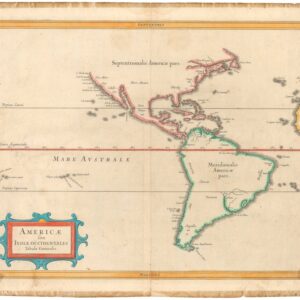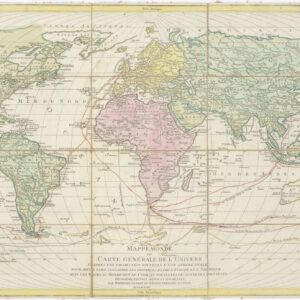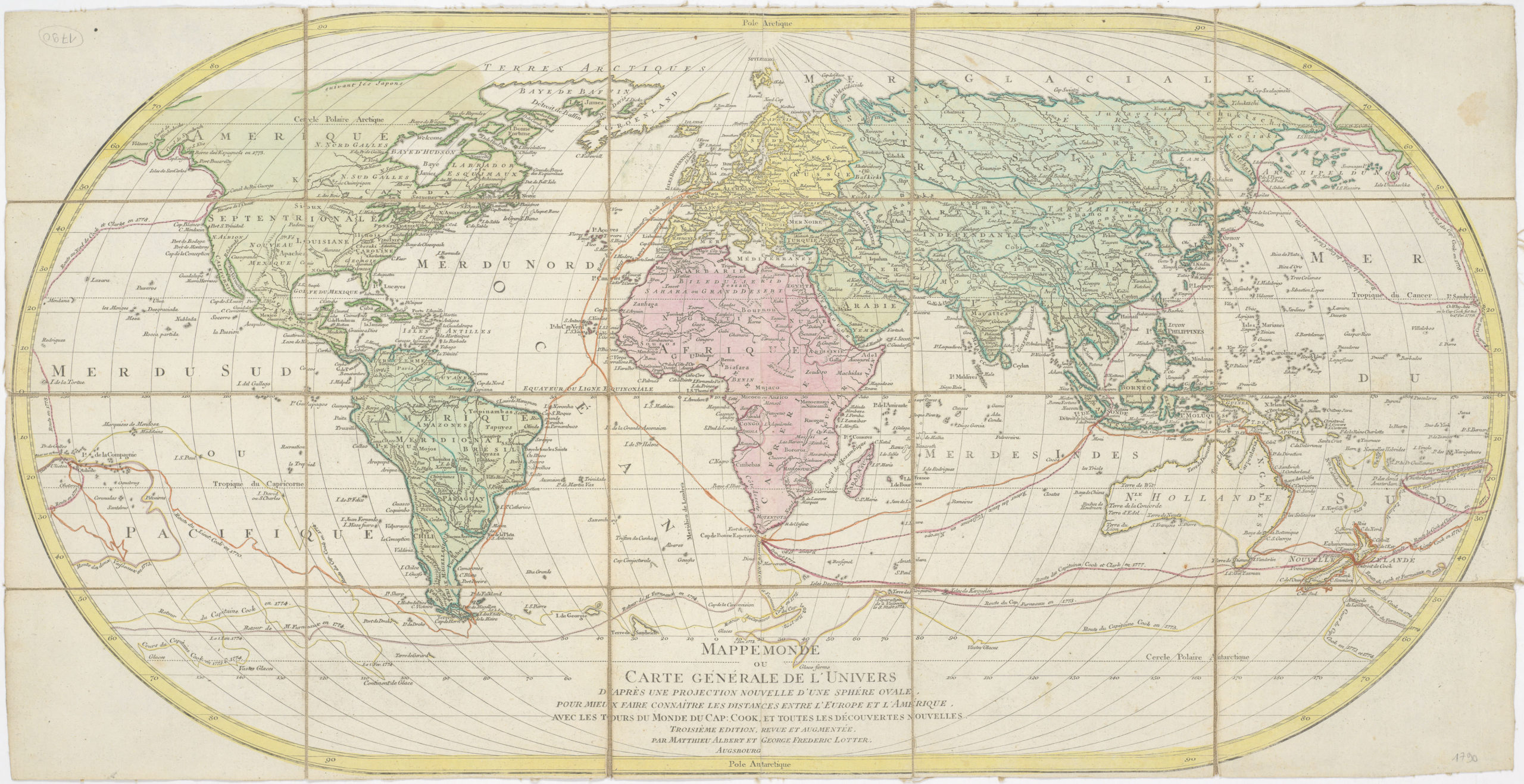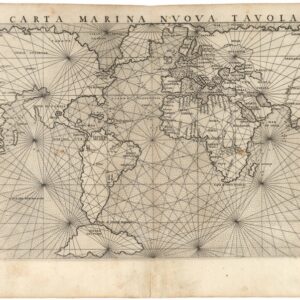The finest Italian facsimile of Fra Mauro’s spectacular 1459 planisphere of the world.
Mappamondo di Fra Mauro.
Out of stock
Description
This large circular planisphere is a high-quality 1:1 facsimile of the famous and monumental Fra Mauro Map from 1459. The Fra Mauro map is one of the most detailed and comprehensive cartographic works of the Middle Ages, accurately reflecting the state of geographical knowledge in the mid-15th century.
The first thing one notices when admiring the map is its overwhelming size and beauty. Capturing the world was a profoundly difficult task in the mid-15th century. Mauro demonstrates his intellectual prowess and resourcefulness by endowing his enormous chart with astounding pictorial and textual detail. In this way, the map was not only a representation of the known world but also a billboard for the erudition of its maker.
The circular map represents the three known continents – Europe, Africa, and Asia – bounded on all sides by a great ocean. Unlike many of his contemporaries, Fra Mauro placed south at the top of the map. In general, Fra Mauro was skeptical of the authority that most attributed to Ptolemy, for he drew on a much more comprehensive range of source material to compile this stunning masterpiece. The map incorporates data from ancient sources, such as Pliny and Ptolemy, to far more contemporary writers, such as fellow Venetian explorers Marco Polo and Niccolò de Conti. Mauro uses many sources to explain and contextualize what he shows on the map, be it flora and fauna, strange peoples with exotic customs, or local sailing conditions.
Just as crucial for the compilation of this masterpiece as the written sources were the hand-drawn nautical charts known as portolans. For centuries, these charts had been produced specifically for navigation purposes, and it was from the portolan tradition that new ideas like rhumb-line networks were introduced. The impact of the portolan tradition on Fra Mauro’s map is, among other things, evident in the inclusion of compass roses along the edges of the map. It is also found in the artistic way that many of the map’s elements are rendered. Rivers and seas flow in magnificent blue and white swirls, while cities and mountains are exaggerated in size and given realistic attributes such as iconic architecture. In many cases, themes’ outstanding features have been enhanced with gold leaf (not just on the original, but also on this excellent facsimile).
In each of the map’s corners, a distinct circular diagram represents a vital feature of the universe, as Fra Mauro understood it. Moving clockwise from the top left, we first have a depiction of celestial spheres according to Ptolemy, then a representation of the four elements, followed by a depiction of the Garden of Eden, and lastly, a schematic rendition of the globe we inhabit. Yet while Fra Mauro’s magnificent chart strove to illustrate the known world, and its maker was among the most informed people in Europe at the time, it was also a highly speculative document. Many unknown or uncharted territories have been configured based on nothing more than myth and imagination.
As with the original, the Editalia facsimile measures an impressive 2.4 by 2.4 m. It consists of multiple sheets of thick paper backed on fine linen and enhanced with gold.
Context is Everything
The Fra Mauro map was created in Venice for a 1457 commission by Afonso V, the King of Portugal. Afonso desired a world map to aid the Portuguese endeavors along the West African coast. Of particular importance to the Portuguese king was a considered assessment of whether or not India could be reached by sailing east (either through or around Africa). Fra Mauro addresses this in at least two legends on the map, insisting that the Indian Ocean is not a closed sea and drawing on authorities like Pliny to reject the Ptolemaic model. The rejection implied accessibility via the Atlantic and was not only what the Portuguese wanted to hear but also one of Mauro’s most significant contributions to the history of cartography.
The large planisphere depicts the world as a manageable entity but, more importantly, as an accessible one (especially for the Portuguese). Commissioning the map was not only about getting the most up-to-date geographical understanding but was also an announcement to the world of Portugal’s plans to expand its maritime activities in the coming decades. In this regard, it is essential to note that the preceding years had seen King Afonso V win papal support for the claim of all lands south of Cape Bojador (Romanus Pontifex in 1445 and Inter Caetera in 1456).
The map was delivered to Lisbon in the spring of 1459, along with a letter from the Doge of Venice to Henry the Navigator (Infante D. Henrique), revealing the level at which this transaction took place. A German humanist saw Fra Mauro’s map hanging in the Royal Palace (Castelo São Jorge) in 1494, but it has been lost since then. Nevertheless, The map was so impressive and essential that the Venetian authorities commissioned their copy, which was completed by August 1459. This second example has survived until today, on which our facsimile is based. Today, the original Fra Mauro map is in the Biblioteca Nazionale Marciana in Venice, where it continues to be admired for its beauty and significance.
Census
This 1:1 facsimile was produced by Editalia in Rome in 1991. The OCLC does not list any institutional examples of this map, and we have not been able to find examples on the open market.
Cartographer(s):
Editalia (1952- ): Editalia has been an essential player in Italy’s cultural and artistic repertoire for seventy years. Founded by Lidio Bozzini in Rome in 1952, Editalia has focused on contemporary art and fine art publishing, producing objects designed to become family heirlooms. In 1972, Eugenio Montale awarded Editalia the prestigious Libro d’Oro, recognizing the scientific and cultural rigor of its texts and iconographic documentation, combined with a publishing quality and graphic elegance worthy of the best Italian bookmaking tradition. In 1991, Editalia merged with the Istituto Poligrafico e Zecca dello Stato. And began producing artistic volumes related to Italian architecture and culture. Part of this initiative produced high-quality facsimiles of precious illuminated manuscripts, such as the Fra Mauro map.
Fra MauroFra Mauro (c. 1385-1464) was a renowned Venetian cartographer and cosmographer. Educated around 1400, he traveled extensively as a soldier and merchant before eventually becoming a monk in the Camaldolese Monastery of San Michele di Murano in Venice, where he served as the monastery’s cartographer. Fra Mauro is known to have produced a range of early charts, but only his monumental world map from 1459 has survived. His contributions to cartography were so significant that his contemporaries dub him an ‘incomparable geographer.’ Fra Mauro’s planisphere of the world remained an essential reference that influenced the development of cartography for decades after its maker’s death.
Condition Description
The map is segmented and mounted on linen. Following the original, it has been extensively enhanced with gold leaf. It is generally in good condition, with only a few tiny scuff marks on the edges of the paper and some marks from the adhesive tape on the verso of the linen backing (see photos). According to the previous owner, it was acquired directly from Editalia in 1991 and has never been displayed.
References
Cattaneao, Angelo (2011). Fra Mauro’s Mappa Mundo and Fifteenth-Century Venice. Turnhout: Brepols. Falchetta, Piero (2006). Fra Mauro’s World Map. Turnhout: Brepols.




![[With Independent Texas] Mappemonde en deux hémisphères.](https://neatlinemaps.com/wp-content/uploads/2024/05/NL-02089_thumbnail-300x300.jpg)